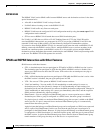
23-16
Catalyst 2960 Switch Software Configuration Guide
78-16881-01
Chapter 23 Configuring SPAN and RSPAN
Configuring SPAN and RSPAN
To monitor all VLANs on the trunk port, use the no monitor session session_number filter global
configuration command.
This example shows how to remove any existing configuration on SPAN session 2, configure SPAN
session 2 to monitor traffic received on Gigabit Ethernet trunk port 2, and send traffic for only VLANs
1 through 5 and VLAN 9 to destination Gigabit Ethernet port 1.
Switch(config)# no monitor session 2
Switch(config)# monitor session 2 source interface gigabitethernet0/2 rx
Switch(config)# monitor session 2 filter vlan 1 - 5 , 9
Switch(config)# monitor session 2 destination interface gigabitethernet0/1
Switch(config)# end
Configuring RSPAN
These sections contain this configuration information:
• RSPAN Configuration Guidelines, page 23-16
• Configuring a VLAN as an RSPAN VLAN, page 23-17
• Creating an RSPAN Source Session, page 23-18
• Creating an RSPAN Destination Session, page 23-19
• Creating an RSPAN Destination Session and Configuring Incoming Traffic, page 23-20
• Specifying VLANs to Filter, page 23-22
RSPAN Configuration Guidelines
Follow these guidelines when configuring RSPAN:
• All the items in the “SPAN Configuration Guidelines” section on page 23-10 apply to RSPAN.
• As RSPAN VLANs have special properties, you should reserve a few VLANs across your network
for use as RSPAN VLANs; do not assign access ports to these VLANs.
• You can apply an output ACL to RSPAN traffic to selectively filter or monitor specific packets.
Specify these ACLs on the RSPAN VLAN in the RSPAN source switches.
• For RSPAN configuration, you can distribute the source ports and the destination ports across
multiple switches in your network.
• RSPAN does not support BPDU packet monitoring or other Layer 2 switch protocols.
• The RSPAN VLAN is configured only on trunk ports and not on access ports. To avoid unwanted
traffic in RSPAN VLANs, make sure that the VLAN remote-span feature is supported in all the
participating switches.
• Access ports (including voice VLAN ports) on the RSPAN VLAN are put in the inactive state.
Step 7
show monitor [session session_number]
show running-config
Verify the configuration.
Step 8
copy running-config startup-config (Optional) Save the configuration in the configuration file.
Command Purpose


















